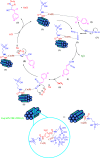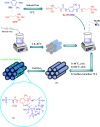Design and characterization of an urea-bridged PMO supporting Cu(II) nanoparticles as highly efficient heterogeneous catalyst for synthesis of tetrazole derivatives
- PMID: 36307538
- PMCID: PMC9616949
- DOI: 10.1038/s41598-022-22905-7
Design and characterization of an urea-bridged PMO supporting Cu(II) nanoparticles as highly efficient heterogeneous catalyst for synthesis of tetrazole derivatives
Abstract
In this work, a new periodic mesoporous organosilica with urea-bridges produced by the reaction of (3-aminopropyl)triethoxysilane and toluene-2,4-diisocyanate (APS-TDU-PMO) is introduced. The obtained APS-TDU-PMO was found to be an appropriate support for loading of Cu(II) nanoparticles to afford supramolecular Cu@APS-TDU-PMO nanocomposite. Uniformity and mesoporosity of both synthesized nanomaterials including APS-TDU-PMO and Cu@APS-TDU-PMO were proved by different spectroscopic, microscopic or analytical techniques including FTIR, EDX, XRD, FESEM, TEM, BET, TGA and DTA. Furthermore, the prepared Cu@APS-TDU-PMO nanomaterial was also used, as a heterogeneous and recyclable catalyst, for the synthesis of tetrazole derivatives through cascade condensation, concerted cycloaddition and tautomerization reactions. Indeed, the main advantages of this Cu@APS-TDU-PMO is its simple preparation and high catalytic activity as well as proper surface area which enable it to work under solvent-free conditions. Also, the introduced Cu@APS-TDU-PMO heterogeneous catalyst showed good stability and reusability for six consecutive runs to address more green chemistry principles.
© 2022. The Author(s).
Conflict of interest statement
The authors declare no competing interests.
Figures











Similar articles
-
Supramolecular Cu(ii) nanoparticles supported on a functionalized chitosan containing urea and thiourea bridges as a recoverable nanocatalyst for efficient synthesis of 1H-tetrazoles.RSC Adv. 2023 Sep 11;13(39):27088-27105. doi: 10.1039/d3ra01989f. eCollection 2023 Sep 8. RSC Adv. 2023. PMID: 37701273 Free PMC article.
-
Supported copper on a diamide-diacid-bridged PMO: an efficient hybrid catalyst for the cascade oxidation of benzyl alcohols/Knoevenagel condensation.RSC Adv. 2021 Dec 20;12(1):437-450. doi: 10.1039/d1ra06509b. eCollection 2021 Dec 20. RSC Adv. 2021. PMID: 35424510 Free PMC article.
-
Synthesis of (E)-2-(1H-tetrazole-5-yl)-3-phenylacrylenenitrile derivatives catalyzed by new ZnO nanoparticles embedded in a thermally stable magnetic periodic mesoporous organosilica under green conditions.Sci Rep. 2022 Jun 24;12(1):10723. doi: 10.1038/s41598-022-13011-9. Sci Rep. 2022. PMID: 35750767 Free PMC article.
-
Design and preparation of nanoarchitectonics of LDH/polymer composite with particular morphology as catalyst for green synthesis of imidazole derivatives.Sci Rep. 2022 Jul 4;12(1):11288. doi: 10.1038/s41598-022-15582-z. Sci Rep. 2022. PMID: 35787674 Free PMC article.
-
Nanomaterial catalyzed green synthesis of tetrazoles and its derivatives: a review on recent advancements.RSC Adv. 2021 Dec 7;11(62):39058-39086. doi: 10.1039/d1ra05955f. eCollection 2021 Dec 6. RSC Adv. 2021. PMID: 35492456 Free PMC article. Review.
Cited by
-
Immobilized Cu(0) nanoparticles on montmorillonite-modified with benzalkonium chloride (MMT-BAC@Cu(0)): as an eco-friendly and proficient heterogeneous nano-catalyst for green synthesis of 5-substituted 1H-tetrazoles.RSC Adv. 2023 Feb 20;13(9):6160-6170. doi: 10.1039/d2ra08208j. eCollection 2023 Feb 14. RSC Adv. 2023. PMID: 36814874 Free PMC article.
-
Mesoporous SBA-16/SO3H from waste sugarcane bagasse ash for efficient Biginelli reactions.Sci Rep. 2025 May 6;15(1):15738. doi: 10.1038/s41598-025-99670-w. Sci Rep. 2025. PMID: 40325160 Free PMC article.
-
Urea-rich porous organic polymer as a hydrogen bond catalyst for Knoevenagel condensation reaction and synthesis of 2,3-dihydroquinazolin-4(1H)-ones.RSC Adv. 2024 Jan 2;14(2):1094-1105. doi: 10.1039/d3ra08354c. eCollection 2024 Jan 2. RSC Adv. 2024. PMID: 38174287 Free PMC article.
-
Supramolecular Cu(ii) nanoparticles supported on a functionalized chitosan containing urea and thiourea bridges as a recoverable nanocatalyst for efficient synthesis of 1H-tetrazoles.RSC Adv. 2023 Sep 11;13(39):27088-27105. doi: 10.1039/d3ra01989f. eCollection 2023 Sep 8. RSC Adv. 2023. PMID: 37701273 Free PMC article.
-
Ultrasound-Promoted preparation and application of novel bifunctional core/shell Fe3O4@SiO2@PTS-APG as a robust catalyst in the expeditious synthesis of Hantzsch esters.Sci Rep. 2023 May 17;13(1):8016. doi: 10.1038/s41598-023-33990-7. Sci Rep. 2023. PMID: 37198267 Free PMC article.
References
-
- Corma A. From microporous to mesoporous molecular sieve materials and their use in catalysis. Chem. Rev. 1997;97:2373–2420. - PubMed
-
- Sayari A, Hamoudi S. Periodic mesoporous silica-based organic−inorganic nanocomposite materials. Chem. Mater. 2001;13:3151–3168.
-
- Ying JY, Mehnert CP, Wong MS. Synthesis and applications of supramolecular-templated mesoporous materials. Angew. Chem. Int. Ed. 1999;38:56–77.
-
- Liu X, Li J, Zhou L, Huang D, Zhou Y. Adsorption of CO2, CH4 and N2 on ordered mesoporous silica molecular sieve. Chem. Phys. Lett. 2005;415:198–201.
-
- Grün M, Kurganov A, Schacht S, Schüth F, Unger K. Comparison of an ordered mesoporous aluminosilicate, silica, alumina, titania and zirconia in normal-phase high-performance liquid chromatography. J. Chromatogr. A. 1996;740:1–9.
Publication types
MeSH terms
Substances
Grants and funding
LinkOut - more resources
Full Text Sources
Miscellaneous

